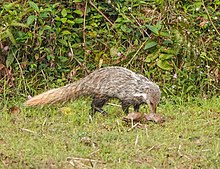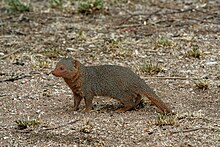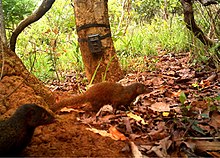몽구스
Mongoose| 몽구스 | |
|---|---|
 | |
| 왼쪽 위: 미어캣 오른쪽 위 : 노란색 몽구스 왼쪽 아래 : 가는 몽구스 오른쪽 아래:인도회색몽구스 | |
| 과학적 분류 | |
| 왕국: | 애니멀리아 |
| 문: | 챠다타 |
| 클래스: | 젖꼭지 |
| 주문: | 육식동물 |
| 서브오더: | 펠리폼리아 |
| 슈퍼 패밀리: | 헤르페스토아목 |
| 패밀리: | 헤르페스과 보나파르트, 1845년 |
| 표준속 | |
| 헤르페스 | |
| 속[1] | |
 | |
| 동의어[1] | |
| 목록.
| |
몽구스는 허페스트과에 속하는 작은 육식 포유동물이다.이 과는 현재 두 개의 아과인 헤르페스티아과와 문고트아과로 나뉜다.Herpestinae는 남유럽, 아프리카, 아시아 원산의 23종의 살아있는 종으로 구성되어 있으며, Mungotinae는 아프리카 [2]원산의 11종으로 구성되어 있습니다.헤르페스티대는 마이오세 초기에 약 2180만 ± 360만 년 전에 발생했으며 유전적으로 1910만 년에서 1850만 년 [3]사이에 두 개의 주요 유전 계통으로 분리되었다.
어원학
영어 단어 "mongoose"는 18세기와 19세기에 "mungoose"로 철자되곤 했다.이 이름은 인도에서 헤르페스 [4][5][6][7]종에 사용되는 이름에서 유래했다: 고전 [8]힌디어의 뮤구스 또는 마구스, 마라티의 뮤구스, 텔루구의 문기사,[9] 칸나다의 문기,[10] 문기시, 문굴리.[11]
(1698년 이후) 영어 이름의 형태는 민간 [12]어원에 의해 "goose"로 바뀌었다.복수형은 "mongooses"[13]이다.
★★★
몽구스는 긴 얼굴과 몸통, 작고 둥근 귀, 짧은 다리, 길고 끝이 가늘어지는 꼬리를 가지고 있다.대부분은 얼룩덜룩하거나 회색빛을 띠고 있으며, 몇몇은 족제비과와 매우 흡사한 강한 무늬의 털을 가지고 있다.그들의 구부러지지 않는 발톱은 주로 땅을 파는데 사용된다.몽구스는 염소와 마찬가지로 좁고 난형인 동공을 가지고 있다.대부분의 종들은 영토 표시와 생식 상태를 알리는 데 사용되는 큰 항문 향기샘을 가지고 있다.몽구스의 치과 공식은 3.1.3-4.1-23.1.3-4.1-2이다.꼬리를 제외한 머리부터 몸까지 길이는 24~58cm(9.4~22.8인치)입니다.무게 범위는 320g(11온스)에서 5kg(11파운드)[14]입니다.
몽구스는 뱀의 [15]독으로부터 보호하는 니코틴성 아세틸콜린 수용체에 돌연변이가 있는 것으로 알려진 포유류 분류군 중 하나이다.그들의 변형된 수용체는 뱀 독의 α-뉴로톡신이 결합하는 것을 막는다.이것들은 4개의 독립된 돌연변이를 나타냅니다.몽구스에서 이 변화는 글리코실화에 [16]의해 특이하게 영향을 받는다.
헤르페스티나는 몽구스를 비베리대의 [17]아과로 간주했던 1845년 샤를 뤼시앙 보나파르트에 의해 제안된 학명이다.1864년, 존 에드워드 그레이는 몽구스를 갈리디아과, 허페스티아과,[18] 문고트아과의 세 아과로 분류했다.이 분류는 1919년 레지날드 이네스 포콕(Reginald Innes Poccock)이 지원했으며, 그는 이 과를 문고트과(Mungotidae)[19]라고 불렀다.
핵과 미토콘드리아 DNA 분석에 기초한 유전자 연구는 갈리디아과가 fossa와 Malagasy [20][21]사향고양이를 포함한 마다가스카르 육식동물과 더 밀접한 관련이 있다는 것을 밝혀냈다.갈리디아과(Galidiinae)는 현재 갈리디아과(Epleridae)[22]의 아과로 간주된다.
| 패밀리 | genus | species | 유형종 이미지 |
|---|---|---|---|
| 일리거, 1811년 [23] |  | ||
| 아틸락스 큐비에르, 1826[29] | 마쉬몽구스 (A. paludinosus) (Cuvier,[30] 1829) |  | |
| 시닉티스 오길비, 1833년[31] | 노랑몽구스 (C. penicillata) (Cuvier, 1829)[30] |  | |
| 우르바 호지슨, 1836년[32] |
|  | |
| 이체네미아 제프로이 생힐레르, 1837년[38] | 흰꼬리몽구스 (I. albicauda) (Cuvier, 1829)[30] |  | |
| 브데오갈레 피터스, 1850년[39] |  | ||
| 린초갈레 토마스, 1894[45] | 멜러 몽구스(R. meleri) 그레이, 1865년[18] |  | |
| 파라시닉티스 포콕, 1916 | 셀러스망구스(P. selousi) (de Winton, 1896년) |  | |
| 크세노게일 알렌, 1919[46] | 긴코몽구스 (X. naso) (de Winton, 1901)[47] |  | |
| 문고트아과 | 문고스 E. Geofroy Saint-Hilaire & F.큐비에르, 1795[48] |  | |
| 수리카타 데스마레스트, 1804[51] | 미어캣 (S. suricatta) (슈레버, 1776년)[52] |  | |
| 크로사르쿠스 큐비에르, 1825 |  | ||
| 헬로게일 그레이, 1861년 |
|  | |
| 둘로게일 토마스, 1920년 | 푸사르게스 몽구스 (D. dybowskii) 푸사르게스, 1894년[53] |  | |
| 리베리익티스 헤이먼, 1958년 | 라이베리아 몽구스 (L. kuhni) 헤이먼, 1958년 |
계통발생학적 관계
18종의 몽구스 종에 대한 계통학 연구는 홀로 사는 몽구스와 사회적인 몽구스가 다른 군락을 [54]형성한다는 것을 밝혀냈다.Herpestidae의 계통학적 관계는 다음 [55][3]분지도에 나와 있다.
| 헤르페스과 |
| ||||||||||||||||||||||||||||||||||||||||||||||||||||||||||||||||||||||||||||||||||||||||||||||||||||||||||||||||||||||||||||||||||||||||||||||||||||||||||||||||||||||||||||||||||||||||||
멸종종
- § A.메소테스 EWER 1956
- § H. lemanensis Pomel, 1853
- § L. atavus Beaumont, 1973
- § L. aurelianensis Schlosser, 1888
- § L. filholi Gaillard, 1899
- § L. mbitensis Schmidt-Kittler, 1987
- § L. namibiensis Morales et al., 2008
- § L. peignei, Grohé et al., 2020
- § L. 랑와이 슈미트-키틀러, 1987
- § L. senutae Morales 등,
행동과 생태
몽구스는 주로 곤충, 게, 지렁이, 도마뱀, 새, 설치류를 먹고 삽니다.그러나 그들은 또한 달걀과 [57]썩은 고기를 먹는다.
어떤 종들은 간단한 재주를 배울 수 있다.그들은 반쯤 길들여질 수 있고 해충을 [58]통제하기 위해 애완동물로 길러진다.
문화적 의의
고대 메소포타미아에서 몽구스는 뱀으로부터 보호하기 위해 소환된 마법의 신 닌기라마와 결합된 닌기림 신에게 신성시되었다.바빌로니아 속담에 따르면 쥐가 몽구스에서 뱀구멍으로 도망갔을 때 "뱀 차머의 안부를 전합니다!"라고 발표했다고 한다.몽구 바빌로니아의 당화 예술에도 몽구스를 닮은 생물이 등장하지만 그 의미는 [59]알려지지 않았다.
1996년 뉴질랜드 위험물질 및 신생물법에 따라 수리카타 수리카타를 제외한 모든 몽구스 종은 '금지 신생물'로 분류돼 국내 [60]반입을 금지하고 있다.
잘 알려진 허구 몽구스는 Rudyard Kippling의 정글북에 나오는 같은 제목의 단편 소설에 등장하는 Rikki-Tikki-Tavi이다.인도를 배경으로 한 이 이야기에서 어린 애완 몽구스는 두 마리의 코브라인 나그와 나가나로부터 그의 인간 가족을 구한다.이 이야기는 나중에 여러 편의 영화와 다른 참고 자료들 중에서 도노반에 의해 노래로 만들어졌다.몽구스는 브람 스토커의 소설 하얀 벌레의 소굴에도 등장한다.주인공인 아담 살튼은 뱀을 독립적으로 사냥하기 위해 뱀을 구입한다.또 다른 몽구스는 아서 코난 도일의 셜록 홈즈 이야기 "비뚤어진 남자의 모험"의 대단원에 등장한다.인도 타밀 숭배 영화 파다이 비투 암만은 타밀 배우 비누 차크라바르시가 암만 여신과 싸우기 위해 사악한 탄트라 만트라로 자신을 몽구스로 바꾸는 모습을 보여준다.하지만 몽구스는 마침내 여신의 손에 죽는다.
몽구스 종은 [61]미국에서 애완동물로 기르는 것이 금지되어 있다.
「 」를 참조해 주세요.
레퍼런스
- ^ a b Wozencraft, W. C. (2005). "Family Herpestidae". In Wilson, D. E.; Reeder, D. M. (eds.). Mammal Species of the World: A Taxonomic and Geographic Reference (3rd ed.). Johns Hopkins University Press. pp. 562–571. ISBN 978-0-8018-8221-0. OCLC 62265494.
- ^ Gilchrist, J.S.; Jennings, A.P.; Veron, G. & Cavallini, P. (2009). "Family Herpestidae (Mongooses)". In Wilson, D. E. & Mittermeier, R. A. (eds.). Handbook of the Mammals of the World. Vol. 1. Carnivores. Barcelona: Lynx Edicions. pp. 262–328. ISBN 978-84-96553-49-1.
- ^ a b c d Patou, M.; Mclenachan, P.A.; Morley, C.G.; Couloux, A.; Jennings, A.P.; Veron, G. (2009). "Molecular phylogeny of the Herpestidae (Mammalia, Carnivora) with a special emphasis on the Asian Herpestes". Molecular Phylogenetics and Evolution. 53 (1): 69–80. doi:10.1016/j.ympev.2009.05.038. PMID 19520178.
- ^ Valentini, M.B. & Major, J.D. (1714). "Viverra Indica grysea. Mungos". Museum museorum, oder, Vollständige Schau Bühne aller Materialien und Specereyen. Vol. 2 Appendix IX. Franckfurt am Mayn: Johann David Zunners Sel. Erben, und Johann Adam Jungen. p. 24.
- ^ Jerdon, T.C. (1874). "127. Herpestes griseus". The mammals of India; a natural history of all the animals known to inhabit continental India. London: J. Wheldon. pp. 132–134.
- ^ Sterndale, R.A. (1884). "Herpestidae. The Ichneumon or Mungoose Family". Natural history of the Mammalia of India and Ceylon. Calcutta: Thacker & Spink. pp. 222–228.
- ^ Lydekker, R. (1894). "XIII. The Mungooses. Genus Herpestes". A hand-book to the Carnivora. Part 1: Cats, civets, and mungooses. London: Edward Lloyd Limited. pp. 244–269.
- ^ Platts, J.T. (1884). "منگوس मुंगूस muṅgūs, or मंगूस maṅgūs. The Mongoose, or ichneumon, Viverra ichneumon". A dictionary of Urdu, classical Hindi, and English. London: W. H. Allen & Co. p. 1081.
- ^ Molesworth, J. T. (1857). "मुंगूस muṅgūsa, Bengal Mungoose, Viverra Ichneumon, or Herpesteus Griseus". A dictionary, Marathi and English (Second, revised and enlarged ed.). Bombay: Printed for Government at the Bombay Education Society's Press. p. 384.
- ^ Brown, C.P. (1903). "ముంగి or ముంగిస mungi. The ichneumon or mongoose, a kind of weasel. Viverra ichneumon". A Telugu-English dictionary (New, thoroughly revised and brought up to date second ed.). Madras: Promoting Christian Knowledge. p. 997.
- ^ Reeve, W. & Sanderson, D. (1858). "ಮುಂಗಿ, ಮುಂಗಿಸಿ, ಮುಂಗುಲಿ". A dictionary, Canarese and English (Revised, corrected and enlarged ed.). Bangalore: Wesleyan Mission Press. p. 787.
- ^ Forsyth, M. (2012). "Folk etymology". The Etymologicon: A Circular Stroll Through the Hidden Connections of the English Language. Penguin Books. p. 77. ISBN 9781101611760.
- ^ Hinton, H. E. & Dunn, A. M. S. (1967). "Preface". Mongooses: Their Natural History and Behaviour. Berkeley: University of California Press. p. v. OCLC 1975837.
- ^ Macdonald, D., ed. (2009). The Encyclopedia of Mammals. Oxford: Oxford University Press. p. 660. ISBN 978-0-19-956799-7.
- ^ Barchan, D.; Kachalsky, S., Neumann, D., Vogel, Z., Ovadia, M., Kochva, E. and Fuchs, S. (1992). "How the mongoose can fight the snake: the binding site of the mongoose acetylcholine receptor" (PDF). Proceedings of the National Academy of Sciences. 89 (16): 7717–7721. Bibcode:1992PNAS...89.7717B. doi:10.1073/pnas.89.16.7717. PMC 49782. PMID 1380164.
{{cite journal}}: CS1 maint: 여러 이름: 작성자 목록(링크) - ^ Drabeck, D. H.; Dean, A. M.; Jansa, S. A. (2015). "Why the honey badger don't care: Convergent evolution of venom-targeted nicotinic acetylcholine receptors in mammals that survive venomous snake bites". Toxicon. 99: 68–72. doi:10.1016/j.toxicon.2015.03.007. PMID 25796346.
- ^ Bonaparte, C. L. (1845). "Fam. VII. Viverridae". Catalogo Methodico dei Mammiferi Europei. Milan, Italy: L. di Giacomo Pirola. p. 8.
- ^ a b Gray, J.E. (1865). "A revision of the genera and species of viverrine animals (Viverridae) founded on the collection in the British Museum". Proceedings of the Zoological Society of London: 502–579.
- ^ Pocock, R. I. (1919). "The classification of mongooses (Mungotidae)". The Annals and Magazine of Natural History. 9 (3): 515–524. doi:10.1080/00222931908673851.
- ^ Yoder, A. D.; Burns, M. M.; Zehr, S.; Delefosse, T.; Veron, G.; Goodman, S. M.; Flynn, J. J. (2003). "Single origin of Malagasy carnivora from an African ancestor". Nature. 421 (6924): 434–437. Bibcode:2003Natur.421..734Y. doi:10.1038/nature01303. PMID 12610623. S2CID 4404379.
- ^ Flynn, J. J.; Finarelli, J.; Zehr, S.; Hsu, J.; Nedbal, M. (2005). "Molecular phylogeny of the Carnivora (Mammalia): Assessing the Impact of Increased sampling on resolving enigmatic relationships". Systematic Biology. 54 (2): 317–337. doi:10.1080/10635150590923326. PMID 16012099.
- ^ Wilson, D.E.; Reeder, D.M., eds. (2005). Mammal Species of the World: A Taxonomic and Geographic Reference (3rd ed.). Johns Hopkins University Press. ISBN 978-0-8018-8221-0. OCLC 62265494.
- ^ Illiger, C. (1815). "Überblick der Säugethiere nach ihrer Verteilung über die Welttheile". Abhandlungen der Königlichen Preußischen Akademie der Wissenschaften zu Berlin. 1804−1811: 39−159.
- ^ Linnaeus, C. (1758). "Viverra ichneumon". Caroli Linnæi Systema naturæ per regna tria naturæ, secundum classes, ordines, genera, species, cum characteribus, differentiis, synonymis, locis. Vol. Tomus I (Decima, reformata ed.). Holmiae: Laurentius Salvius. p. 41. (라틴어)
- ^ Rüppell, E. (1835). "Herpestes sanguineus. Rüppell". Neue Wirbelthiere zu der Fauna von Abyssinien gehörig. Frankfurt am Main: S. Schmerber. pp. 27–28.
- ^ Wagner, J.A. (1839). "Über die Verwandtschafts-Verhältnisse der Pharaonsratte". Gelehrte Anzeigen der Königlich Bayerischen Akademie der Wissenschaften zu München. 9 (183): 425–429.
- ^ Gray, J.E. (1848). "Description of a new species of Herpestes, from Abyssinia". Proceedings of the Zoological Society of London (November): 138–139.
- ^ Bocage, J.V.B. (1889). "Mammifère d'Angola et du Congo". Jornal de Sciencias mathematicas, physicas e naturaes. 2. 1: 174–185.
- ^ Cuvier, F. G. (1826). "Vansire". In E. Geoffroy Saint-Hilaire; Cuvier, F. G. (eds.). Histoire Naturelle des Mammifères : avec des figures originales, coloriées, dessinées d'aprèsdes animaux vivans. Tome 5. Paris: A. Belin. p. LIV.
- ^ a b c Cuvier, G. (1829). "Les Mangoustes. Cuv. (Herpestes, Illiger)". Le règne animal distribué d'après son organisation, pour servir de base à l'histoire naturelle des animaux et d'introduction à l'anatomie comparée. Paris: Chez Déterville. pp. 157–158.
- ^ Ogilby, W. (1833). "Characters of a new Genus of carnivorous Mammalia from the collection of Mr. Steedman". Proceedings of the Zoological Society of London (Part 1): 48–49.
- ^ a b c Hodgson, B. H. (1836). "Synoptical description of sundry new animals, enumerated in the Catalogue of Nepalese Mammals". Journal of the Asiatic Society of Bengal. 5: 231–238.
- ^ a b Geoffroy Saint-Hilaire, É. (1817). "De l'Ichneumon. Ichneumon pharaon". In Jomard, E. F. (ed.). Description de l'Égypte, ou, Recueil des observations et des recherches qui ont été faites en Égypte pendant l'éxpédition de l'armée française. Vol. Tome II. Paris: Commission des Sciences et Arts d'Egypte. pp. 137–144.
- ^ Bennett, E. T. (1835). "Remarks on some Mammalia from Travancore, including a New Species of Herpestes". Proceedings of the Zoological Society of London. III: 66–67.
- ^ a b Gray, J. E. (1837). "Description of some or little known Mammalia, principally in the British Mueum Collection". The Magazine of Natural History and Journal of Zoology, Botany, Mineralogy, Geology and Meteorology. I (November): 577–587.
- ^ Waterhouse, G. R. (1838). "On two new species of Mammalia, from the Society's collection, belonging to the genera Gerbillus and Herpestes". Proceedings of the Zoological Society of London. VI: 55–56.
- ^ Gray, J.E. (1846). "New species of Mammalia". The Annals and Magazine of Natural History; Zoology, Botany, and Geology. 18 (118): 211–212.
- ^ Geoffroy Saint-Hilaire, I. (1837). "Notices sur deux nouveaux genres de Mammifères carnassiers, les Ichneumies, du continent Africain, et les Galidies de Madagascar". Annales des Sciences Naturelles. 2. 8: 249–252.
- ^ Peters, W. (1850). "Bdeogale". Sitzungsberichte der Gesellschaft Naturforschender Freunde zu Berlin: 94.
- ^ Peters, W. (1852). "Mittheilung über die in Mossambique beobachteten Mangusten". Verhandlungen der Königlich Preussischen Akademie der Wissenschaften zu Berlin: 81–82.
- ^ Pucheran, J.P. (1855). "Les Mammifères de la côte occidental d'Afrique". Revue et magasin de zoologie pure et appliquée. 2. 7: 111.
- ^ Thomas, O. (1894). "On a new African Genus of Mustelidae". The Annals and Magazine of Natural History; Zoology, Botany, and Geology. 6. 13 (78): 522–524.
- ^ Heller, E. (1914). "New antelopes and carnivores from British East Africa". Smithsonian Miscellaneous Collections. 61 (2240): 1–15.
- ^ Foley, C. & Do Linh San, E. (2016). "Bdeogale omnivora". IUCN Red List of Threatened Species. 2016: e.T136686A45221619.
- ^ Thomas, O. (1894). "On the mammals of Nyasaland: third contribution". Proceedings of the Zoological Society of London (February): 136–146.
- ^ Allen, J. A. (1919). "Preliminary notes on African Carnivora". Journal of Mammalogy. 1 (1): 23–31. doi:10.2307/1373716. JSTOR 1373716.
- ^ de Winton, W. E. (1901). "Description of a New Mongoose from West Africa". Bulletin of the Liverpool Museums Under the City Council. 3 (2): 35–37.
- ^ Geoffroy, E. & Cuvier, F. (1795). "Mémoire sur une nouvelle division des Mammifères, et sur Ies principes qui doivent servir de base dans cette sorte de travail, lu à la société d'Histoire naturelle, le premier floréal de l'an troisième". In Millin; Noel & Warens (eds.). Magasin Encyclopédique : ou journal des sciences, des lettres et des arts. Vol. Tome second. Paris: I'lmprimerie du Magazin Encyclopédique. pp. 164–189.
- ^ Gmelin, J. F. (1788). "Viverra mungo". Caroli a Linné, Systema naturae per regna tria naturae, secundum classes, ordines, genera, species, cum characteribus, differentiis, synonymis, locis. Vol. I (13th aucta, reformata ed.). Lipsiae: Georg Emanuel Beer. pp. 84–85.
- ^ Ogilby, W. (1835). "Descriptions of Mammalia and Birds from the Gambia". Proceedings of the Zoological Society of London. Part III: 97–105.
- ^ Desmarest, A. G. (1804). "Genre Surikate, Suricata Nob.". In Deterville, J. F. P. (ed.). Nouveau dictionnaire d'histoire naturelle appliquée aux arts : principalement à l'agriculture et à l'économie rurale et domestique. Vol. 24. Paris: Deterville. p. 15.
- ^ Schreber, J. C. D. (1776). "Viverra suricata". Die Säugethiere in Abbildungen nach der Natur, mit Beschreibungen. Erlangen: Expedition des Schreber'schen Säugthier- und des Esper'schen Schmetterlingswerkes. p. CVII.
- ^ de Pousargues, E. (1894). "Description d'une nouvelle espèce de mammifère du genre Crossarchus et considérations sur la répartition géographique des crossarques rayés". Nouvelles Archives du Muséum d'Histoire Naturelle. 3 (in French). 6: 121–134.
- ^ Veron, G.; Colyn, M.; Dunham, A.E.; Taylor, P.; Gaubert, P. (2004). "Molecular systematics and origin of sociality in mongooses (Herpestidae, Carnivora)". Molecular Phylogenetics and Evolution. 30 (3): 582–598. doi:10.1016/S1055-7903(03)00229-X. PMID 15012940.
- ^ Barycka, E. (2005). "Evolution and systematics of the feliform Carnivora". Mammalian Biology. 72 (5): 257–282. doi:10.1016/j.mambio.2006.10.011.
- ^ Morales, J., Pickford, M. and Salesa, M.J. (2008). "Creodonta and Carnivora from the Early Miocene of the Northern Sperrgebiet, Namibia". Memoir of the Geological Survey of Namibia. 20: 291–310.
{{cite journal}}: CS1 maint: 작성자 파라미터 사용(링크) - ^ Cronk, N. E.; Pillay, N. (2018). "Food choice and feeding on carrion in two African mongoose species in an urban environment". Acta Ethologica. 21 (2): 127–136. doi:10.1007/s10211-018-0291-x. S2CID 21688548.
- ^ Sherman, D. M. (2007). Tending Animals in the Global Village: A Guide to International Veterinary Medicine. John Wiley & Sons. ISBN 9780470292105.
- ^ Black, J.; Green, A. (1992). Gods, Demons and Symbols of Ancient Mesopotamia: An Illustrated Dictionary. The British Museum Press. p. 132. ISBN 0-7141-1705-6.
- ^ "Hazardous Substances and New Organisms Act 2003 - Schedule 2 Prohibited new organisms". New Zealand Government. Retrieved 26 January 2012.
- ^ Krueger, A. (2010). "Remembering Duluth's famous mongoose, Mr. Magoo". Duluth News Tribune. Archived from the original on 1 February 2014.
추가 정보
- Rasa, A. (1986). Mongoose Watch: A Family Observed. Garden City, N.Y.: Anchor Press, Doubleday & Co. ISBN 9780385231756. OCLC 12664019.
- Lodrick, D. O. (1982). "Man and Mongoose in Indian Culture". Anthropos. 77 (1/2): 191–214. JSTOR 40460438.
외부 링크
- . Encyclopædia Britannica (11th ed.). 1911.


